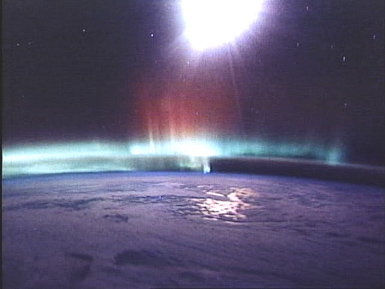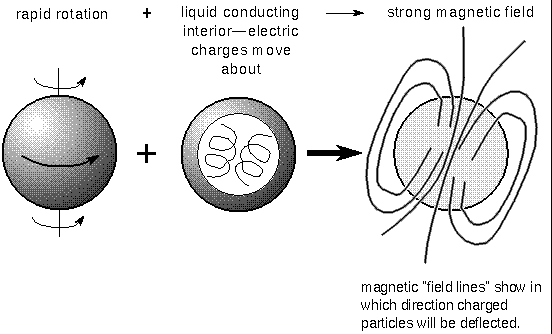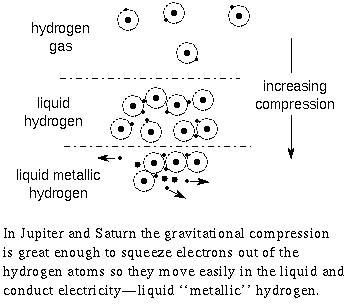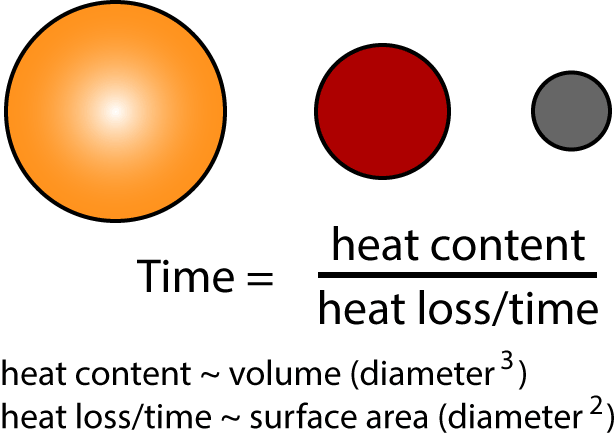
Video lecture for Geology section
Some planets have a magnetic field that acts like there is a giant bar magnet in the center of a planet (there isn't really a giant bar magnet, though). The region surrounding the planet where its magnetic field is the predominant one (i.e., the one that charged particles will respond to instead of to another body's magnetic field) is the magnetosphere.The magnetic field can be aligned differently than the rotational axis. For example, the Earth's magnetic field is tilted by about 18° with respect to our rotation axis, so compasses point to a magnetic pole that is just off the coast of northern Canada.
A planet's magnetic field forms a shield protecting the planet's surface from energetic, charged particles coming from the Sun and other places. The Sun is constantly sending out charged particles, called the solar wind, into the solar system. When solar wind particles run into a magnetic field, they are deflected and spiral around the magnetic field lines. Magnetic "field lines" are imaginary lines used to describe the direction charged or magnetic particles will move when responding to a magnetic field. In the same way, gravity "field lines" point to the center of an object producing the gravity. You can see the direction of an ordinary household magnet's field lines by sprinkling tiny iron filings around a magnetic---they will tend to bunch up along particular magnetic field lines.
Most of the solar wind gets deflected around the planet but a few particles manage to leak into the magnetic field and become trapped in the planet's magnetic field to created radiation belts or "charged particle belts".


One glorious effect seen when the solar wind interacts with a planet's magnetic field is aurorae. Aurorae are shimmering light displays produced by molecules in the upper atmosphere. Fluctuations in the solar wind can give energy to the trapped charged particles in the belts. Particles with enough energy can leave the belts and spiral down to the atmosphere to collide with molecules and atoms in the thermosphere of a planet. These collisions excite the atmosphere molecules (bumping their electrons to higher energy levels). The electrons then release the excess energy as they hop downward back toward the atomic nuclei. The glow of the aurorae is the emission line spectra produced by the electrons in the rarefied gas dropping back down to lower atomic energy levels.

Aurorae in the Earth's atmosphere occur many tens of kilometers above the surface (in the thermosphere) and pose no threat to life on the surface below. They make some spectacular displays that look like shimmering curtains or spikes of different colors of light. The magenta colors are produced by nitrogen molecules at the lower end of the aurorae (up to 100 kilometers above the surface), between 100 and 200 kilometers above the surface excited oxygen atoms produce the green colors and ionized nitrogen atoms produce the blue colors, and greater than 200 kilometers above the surface oxygen atoms produce the deep red colors. In the northern hemisphere, the aurorae are called aurora borealis or "the northern lights" and in the southern hemisphere, they are called aurora australis or "the southern lights." Occasionally the aurorae seem to erupt with a burst of activity of multi-color shimmering of reds, whites, and purples. This happens when stressed or flexing magnetic field lines about a third of the way to the Moon squeeze together and reconnect. That sends a massive burst toward the Earth that hits the upper atmosphere to make the aurora eruption. The Goddard Space Flight Center's "Why Auroras Erupt" page shows a nice animation of this.
For further information (and photos!), explore these sites (all will appear in another window):

Planets do not have giant bar magnets in their cores, so what produces the magnetic field? Recall from the beginning of the Electromagnetic Radiation chapter, that a magnetic field can be produced by circulating electrical charges. A theory called the magnetic dynamo theory says that the magnetic field is produced by swirling motions of liquid conducting material in the planet interiors. Materials that can conduct electricity have some electrical charge that is free to move about. Such materials are called metallic and are not necessarily shiny solids like copper, aluminum, or iron. Jupiter and Saturn have a large amount of hydrogen that is compressed so much it forms a liquid. Some of that liquid hydrogen is in a state where some of the electrons are squeezed out of the atoms and are free to move around.

A moving charge will produce a magnetic field. The liquid conducting material in a planet's interior can be made to swirl about if the planet is rotating quickly enough. The faster a planet rotates, the more the material gets stirred up and, therefore, the stronger the generated magnetic field. If the liquid interior becomes solid or if the rotation slows down, the magnetic field will weaken. So in summary what a planet needs in order to produce a strong magnetic field are (1) a liquid conducting (metallic) interior and (2) rapid rotation to get the conducting material moving about. For the terrestrial planets plate tectonics may also play a role. Plate tectonics cools the planet's mantle creating a large enough temperature difference between the core and mantle to produce the large-scale convection in the metallic core needed to make a magnetic field. Let's see how this theory explains the presence or lack of a magnetic field on some of the planets:
Since it is almost the size of the Earth, its interior should still be very warm. Larger planets lose their heat from formation and radioactive decay more slowly than small planets. A planet with a larger volume than another planet of the same composition will start off with a larger supply of heat energy. In addition, the heat in a large planet's interior has a great distance to travel to reach the planet's surface and the cold outer space.

The rate of heat loss increases with the surface area. A planet with a larger surface area than another planet with the same internal temperature will have a larger rate of heat loss. The time it takes for a planet to cool off depends on the total amount of heat stored/rate of heat loss or (its volume)/(its surface area). Recall from the planet volume section that the volume increases as the diameter3. The surface area increases as only the diameter2, so the planet's cooling time increases as diameter3/diameter2 = diameter. Even though its heat loss rate is greater, a larger planet has a much larger amount of energy stored in it and, thus, it will take longer to cool off than a smaller planet. Venus should have a iron-nickel core that is still liquid like the Earth's.
Jupiter's magnetic field is so large that from the Earth it has an angular size over four times the size of our Moon. One of the first radio sources detected from space was Jupiter. Charged particles in Jupiter's radiation belts that are energized by the solar wind spiral around magnetic field lines to produce electromagnetic radiation in many different frequency bands. For Jupiter a lot of this energy is in the form of radio. In addition, there is a flux tube of electrical current of millions of amps flowing between Jupiter and its very geologically-active moon, Io. As described in the Jupiter moons section, Io has a number of volcanoes erupting all of the time. Particles in Jupiter's radiation belts collide with the volcanic dust particles and charge them, further adding to the radiation belts. Charged particles flowing back and forth produce aurorae larger than the entire Earth. Spacecraft sent to Jupiter have to be specially "radiation-harded" to protect their electronics from the charged particles in Jupiter's radiation belts.
Mercury's situation was a major challenge to the magnetic dynamo theory. In true scientific fashion, the theory made a testable prediction: Mercury should have no magnetic field or one even less than Mars' one because its core should be solid. Observation, the final judge of scientific truth, contradicted the prediction. Should we have thrown out the magnetic dynamo theory then? Astronomers were reluctant to totally disregard the theory because of its success in explaining the situation on the other planets and the lack of any other plausible theory.
So most take a more conservative route: either modifying the magnetic dynamo theory or investigating Mercury more closely to find out what is so unusual about its interior to produce a magnetic field despite our expectations. Is their reluctance a violation of the objectivity required in science? Perhaps, but past experience has taught us that when your are confronted with such a contradiction, nature is telling you that you forgot to take something into account or you overlooked a crucial process. The MESSENGER mission confirmed the existence of Mercury's liquid core through careful tracking of the spacecraft's motion in Mercury's gravity field. The Mercury spin data and gravity field measurements have solved part of the problem (part of the core is molten), but how has the core remained molten and convecting (even partially) despite Mercury's small size? MESSENGER also found that the magnetic field is offset toward the north pole by about 20% of Mercury's radius. This offset suggests that Mercury's dynamo is created near the core-mantle boundary.
Another example of this conservative route is the discovery of the planet Neptune. When its near twin planet, Uranus, was discovered, astronomers were very confident in Newton's gravity theory because of its over a hundred-year success rate in explaining the motions of many different types of objects. So they applied Newton's gravity theory to Uranus' orbit. However, after several decades of further observation of Uranus, the predicted orbit was significantly different from the observed orbit. Rather than throwing out Newton's gravity theory, astronomers used the contradiction to predict the presence of another planet beyond Uranus. Within a couple of years, Neptune was discovered at the position predicted! Might the same sort of thing be happening with the magnetic dynamo theory and Mercury's magnetic field? Perhaps. One thing is for sure, scientists love a good puzzle and will work hard at trying to solve it.
| aurorae | magnetic dynamo | solar wind |
|---|
![]() Go back to previous section --
Go back to previous section --
![]() Go to next section
Go to next section
last updated: June 3, 2023